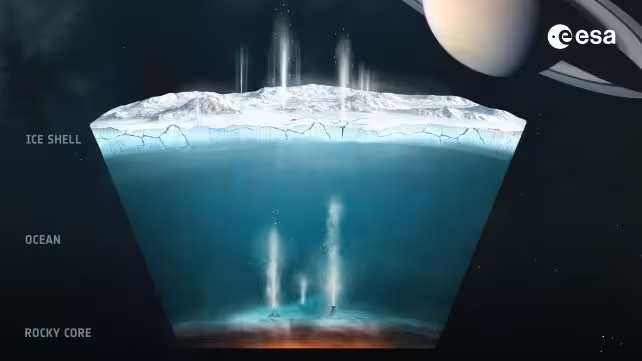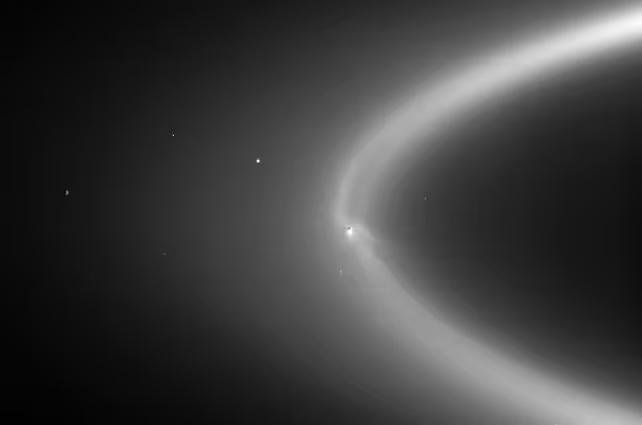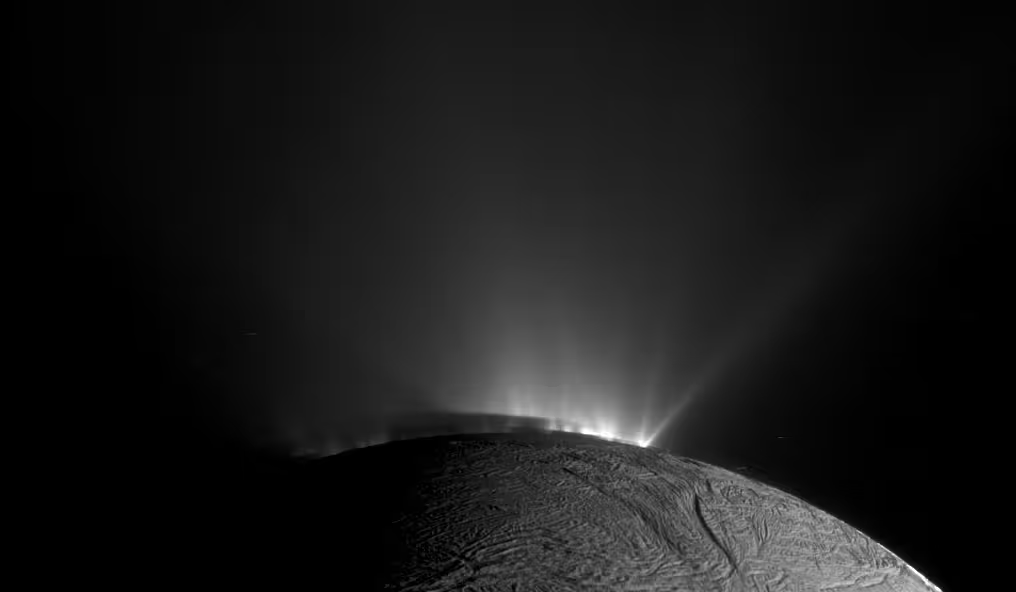6 Minutes
Main findings and significance
A renewed analysis of NASA Cassini data has uncovered a diverse suite of complex organic molecules in material freshly ejected from cracks in Saturn's moon Enceladus. Researchers led by astrobiologist Nozair Khawaja (University of Stuttgart) re-examined high-velocity plume fly-through spectra and identified multiple chemical families — including aromatics, aldehydes, esters, ethers and alkenes — some seen for the first time in freshly produced plume grains. These discoveries strongly point to active, complex chemistry within Enceladus's subsurface ocean and provide new context for evaluating the moon's habitability.
Unlike previous work that relied largely on older, space-weathered ice grains in Saturn's E ring, this study focused on recently expelled plume particles collected directly during Cassini fly-throughs. That distinction matters: freshly ejected grains carry a clearer chemical signature of the interior ocean and seafloor processes, while E-ring particles are modified by micrometeoroid bombardment, radiation and other space-weathering effects.
Scientific background and Cassini mission data
Cassini sampled Enceladus's plumes multiple times between 2005 and 2015. The probe's Cosmic Dust Analyzer (CDA) instrument recorded hundreds of thousands of ice grain spectra across those encounters. However, data from direct plume fly-throughs tended to be noisier and challenging to interpret. A particularly valuable dataset came from a 2008 high-speed pass when Cassini traversed a plume at 17.7 kilometers per second. The extreme impact speeds produced unique spectral signatures that are otherwise unobtainable.

A diagram of how scientists think hydrothermal activity occurs on Enceladus. (ESA)
Khawaja and colleagues applied updated analysis methods — including laboratory spectral matching against expanded open-access libraries — to disentangle the noise and isolate organic signals. At lower impact speeds, ice molecules fragment and cluster in ways that can mask organics. At higher velocities, water molecule clustering is reduced, revealing organic peaks that were previously hidden. This methodological advance enabled the detection of multiple organic classes and provided stronger evidence that these molecules originate from Enceladus's interior rather than from alteration in space.
Why the organic suite matters
The inventory of detected molecules complements earlier Cassini findings of salts, molecular hydrogen and phosphates in the plumes. Together these results confirm the presence of five of the six CHNOPS elements (carbon, hydrogen, nitrogen, oxygen, phosphorus, sulfur) essential to terrestrial biochemistry; sulfur remains the only major element not yet clearly detected. Although the newly identified organics can be produced abiotically, many are precursors or intermediates in pathways relevant to biological chemistry.

Cassini image of Enceladus in the E ring, showing the bright plumes. (NASA/JPL/Space Science Institute)
Importantly, the chemical mix resembles compounds produced by Earth's deep-ocean hydrothermal vent systems. On Earth, hydrothermal vents host rich ecosystems that thrive without sunlight, relying instead on chemical energy and complex organic synthesis at hot seafloor interfaces. The Enceladus data are now the strongest observational evidence yet that similar hydrothermal processes may be occurring today at the moon's seafloor.
Implications for habitability and astrobiology
Enceladus remains one of the most promising locations in the Solar System to search for signs of life because it combines a global subsurface ocean, internal heat production from tidal flexing, and a demonstrated mechanism — plumes — that transports ocean material into space for remote sampling. The detection of diverse organics adds a crucial piece to the habitability puzzle by showing that not only are raw ingredients present, but active chemical processes are generating complex molecules.

A 2010 Cassini image of jets spurting from Enceladus. (NASA/JPL-Caltech/Space Science Institute)
The research team emphasizes that all identified pathways are abiotic, meaning they do not require life to form these molecules. Yet the presence of these compounds raises the probability that Enceladus could support life or at least prebiotic chemistry. As Khawaja summarized in the study context, 'There are many plausible chemical routes from the organics we detected to more biologically relevant compounds, which increases the chance that conditions suitable for life could exist within the moon.'
Mission and technological context
Cassini's unique set of instruments, particularly the CDA and mass spectrometers, enabled this retrospective discovery. Advances in spectral databases, laboratory analog experiments, and signal-processing algorithms proved equally important. The ability to mine archival data with modern methods underscores the long-term scientific value of flagship missions and strengthens the case for future dedicated missions to Enceladus.
Future mission concepts propose low-altitude plume sampling with improved mass spectrometers, cryogenic collection systems to preserve fragile organics, and, eventually, surface or penetrator investigations of the icy shell and warm regions near fractures. Each technological step would refine our understanding of whether complex chemistry on Enceladus progresses toward genuinely biological processes.
Expert Insight
'These findings show how much information can be recovered from well-preserved plume material,' says Dr. Larissa Moreno, an oceanographer and astrobiologist not affiliated with the study. 'The suite of organics Kassini-derived spectra now reveals is consistent with active seafloor chemistry; that doesn't prove life, but it makes Enceladus an even more compelling target for focused exploration.'
'Even if future missions find no living organisms,' adds Dr. Moreno, 'that result would be scientifically profound: it would challenge our understanding of the transition from complex chemistry to biology, under conditions that appear otherwise suitable.'
Conclusion
The renewed analysis of Cassini plume data strengthens the evidence that Enceladus hosts active, complex organic chemistry driven by processes analogous to Earth's hydrothermal systems. While the detected molecules are likely abiotic in origin, they include many precursors relevant to life and confirm a direct link between the moon's interior and the material sampled in space. These results bolster the scientific priority of returning to Enceladus with next-generation instruments designed to probe its ocean and seafloor more directly, and they sharpen one of the most intriguing questions in planetary science: if the right conditions for life exist there, why would life be absent?
There is more to explore in the existing datasets, and ongoing reanalysis may reveal additional compounds and clues. The combination of archival data review, laboratory spectroscopy, and targeted future missions will continue to refine our picture of Enceladus as one of the Solar System's prime laboratories for studying ocean worlds and the chemistry that precedes life.
Source: sciencealert


Leave a Comment